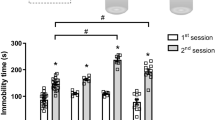Abstract.
Rationale: Recent preclinical and clinical studies have shown that selective serotonin re-uptake inhibitors modulate neurosteroid synthesis in an opposite manner. Objectives: The action of long-term administration of fluoxetine was investigated on the peripheral and central concentrations of 3α,5α-tetrahydroprogesterone (3α,5α-TH PROG) and 3α,5α-tetrahydrodeoxycorticosterone (of 3α,5α-TH DOC), progesterone, and pregnenolone in rats. We also investigated the effect of chronic treatment with fluoxetine on the foot-shock stress-induced increase in the plasma and brain concentrations of these steroids. Methods: Fluoxetine was administered acutely (20 mg/kg) or chronically (10 mg/kg, once daily for 15 days). Steroids were extracted from plasma and brain, separated and purified by means of high-performance liquid chromatography, and quantified by means of radioimmunoassay. Results: A single dose of fluoxetine (20 mg/kg, i.p.) induced in 20 min significant increases in the cerebral cortical and plasma concentrations of 3α,5α-TH PROG (+96% and +13%, respectively), 3α,5α-TH DOC (+129 and +31%, respectively), progesterone (+111 and +58%, respectively), and pregnenolone (+151 and +59%, respectively). In addition, the plasma concentration of corticosterone was also significantly increased (+24%) after acute administration of fluoxetine. In contrast, long-term administration of fluoxetine reduced the basal concentrations of these various steroids (ranging from –22 to –43%), measured 48 h after the last drug injection, in both brain and plasma. A challenge injection of fluoxetine (20 mg/kg, i.p.), however, was still able to increase the concentrations of steroids in both the brain and plasma of rats chronically treated with this drug. Acute foot-shock stress increased the cortical and plasma concentrations of steroids in rats chronically treated with fluoxetine to extents similar to those apparent in control rats. Conclusions: A repetitive increase in the brain concentrations of neuroactive steroids may contribute to the therapeutic action of fluoxetine.
Similar content being viewed by others
Author information
Authors and Affiliations
Additional information
Electronic Publication
Rights and permissions
About this article
Cite this article
Serra, M., Pisu, G.M., Muggironi, M. et al. Opposite effects of short- versus long-term administration of fluoxetine on the concentrations of neuroactive steroids in rat plasma and brain. Psychopharmacology 158, 48–54 (2001). https://doi.org/10.1007/s002130100853
Received:
Accepted:
Issue Date:
DOI: https://doi.org/10.1007/s002130100853




